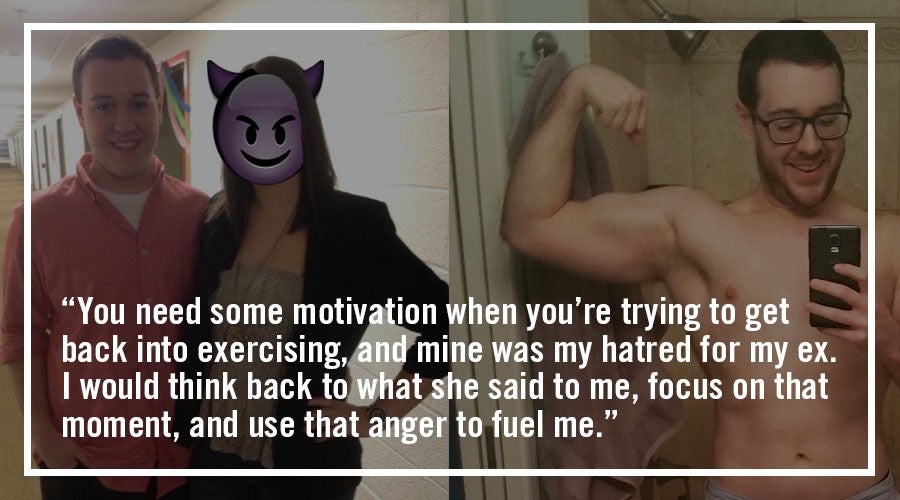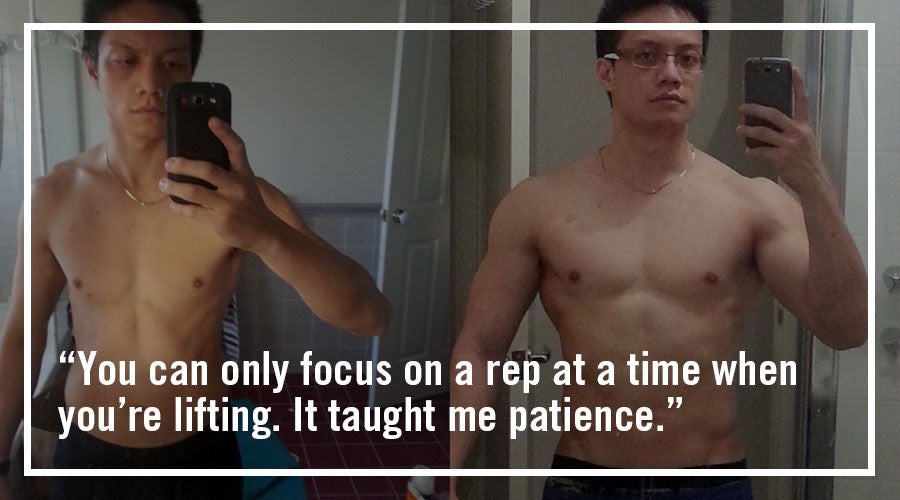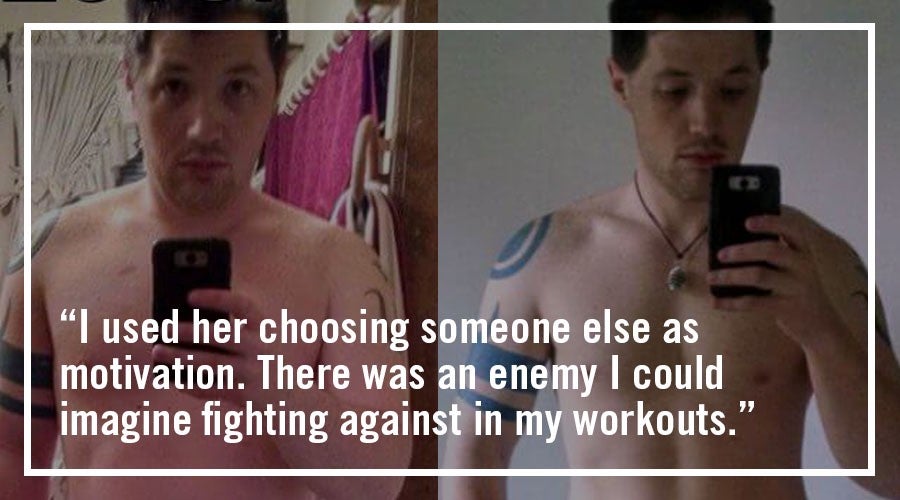Until recently, pop culture portrayed the “revenge bod” as a strictly female phenomenon. As Vanity Fair notes, the term first entered the lexicon in the early 2010s, as a way for glossy celebrity magazines to describe famous women (Jennifer Aniston, Kim Kardashian, Britney Spears, Katie Holmes) who worked themselves into incredible physical shape following their public breakups. By 2015, the term had its own Urban Dictionary listing, kind of (Urban Dictionary has it as revenge body).
The idea (or motivation) behind the revenge bod is to look bangin’ so your piece-of-shit ex is overcome with regret the next time you happen to run into each other. (Or the next time they totally randomly stumble on one of your Instagram photos.) There’s even scientific proof the female version of the revenge bod exists: Women tend to exercise more and lose weight after a divorce, according to a new study out of the University of Arizona.
But society has since discovered the revenge bod is not exclusive to women. This January, E! premiered Revenge Body With Khloe Kardashian, in which she helps both men and women get their own back in the form of a fit new physique. Khloe famously got a revenge bod following her protracted breakup with former NBA All-Star Lamar Odom, culminating in her iconic Complex cover shoot from 2015. (Odom is now working on a revenge bod of his own.)
MEL interviewed three men about their revenge bods and found that the journey is slightly different than it is for women. It’s not so much about getting it tight for the next time they encounter their ex as it is about sublimating their anger. Of course, MEL would prefer men have the emotional tools to handle a breakup, but there are a lot worse ways to handle male rage than to hit the weights.

Brandon Cope, 23, Macungie, Pennsylvania
I did the typical college guy thing when I went off to school — started partying and drinking, and just got lazy and let myself go. I gained the freshman 40.
I was dating a girl during this time, and she would make subtle comments, like, “Maybe you should go for a run or something?” She cheated on me with one of my roommates, and was cruel about my weight gain when we broke up. “Look at what you’ve become,” she said. “You’re going back to the way you were.” (She knew me from back in high school, when I weighed about 270 at one point.)
That’s when I took up CrossFit. It sucked, especially the burpees and rope climbing. You need some motivation when you’re trying to get back into exercising, and mine was my hatred for my ex. I would think back to what she said to me, focus on that moment, and use that anger to fuel me. I’d think to myself, I’m not who she said I was. I’m not going back to that. I really wanted to show her I was better than that.
After about six months, that faded and I realized I was working out for myself again. By the time college ended, my friends and I were going to the gym every day for two hours — one hour of running, another of weight lifting. I lost 50 pounds of fat and gained 20 pounds of muscle since I first started working out again. Now I’m a lean 180 pounds and preparing for my first physique competition.
I’ve seen my ex since she said those things to me. She said I was looking great and she was really proud of me. My hard feelings toward her had already passed, but that was still nice to hear.

Alexander Thien, 32, Perth, Australia
My workout routine wasn’t so much about getting a revenge bod as it was dealing with my anger. My girlfriend and I had known each other since high school and meant a lot to each other, and I felt like I could dull the emotional pain with physical pain, and eventually the heartache would go away.
I had been relatively fit in high school because I was a breakdancer, but it was becoming more and more obvious that I needed to work out to maintain my physique. Gym bros — with their cycling steroids and thinking they’re better than everyone — really put me off. So I found body-weight exercises I could do at home — pull-ups, dips, calf raises, push-ups and squats — and did those twice a day, every day, religiously. Being sore at the end of the day was better than being alone with my thoughts.
I gradually increased the number of reps I was doing, and after about a month I started supplementing my workouts with weight lifting — bicep curls, deadlifts, leg press, shoulder press and weighted squats. You can only focus on a rep at a time when you’re lifting. It taught me patience.
Then I got in touch with an old breakdance friend of mine who had taken up calisthenics and we started working out together in the park. We’d do pistol squats, burpees, squat jumps, muscle ups — exercises that spoke to my breakdancing background. Being in that environment, out in nature, with no high-tempo music and no old men grunting, was calming.
After months of that, my anger subsided. I had been working out so long it had become a habit. And once my friends and family noticed my physical transformation, I was able to take a step back and notice it, too.
About two years after we broke up, my ex and I saw each other again, and there was no bitterness, no tension. That felt like a distant memory.

Patrick Hessman, 26, Raleigh, N.C.
I’ve been through three revenge bod cycles in the past two years. I got into a relationship at the start of 2015. It seemed great at first, but she dropped me for another guy only a month and a half in. But I took something from that relationship: She told me how she did the P90X videos. And in my fit of insecurity, I decided to try it myself.
Other than the soreness, I instantly felt healthier. Bodyweight exercises can be demoralizing when you’re out of shape, even if you’ve been lifting weights a lot. The difficulty of the workout is a reminder you’re overweight to begin with, which feeds into your insecurities. I was overweight as a kid, so I’ve always been self-conscious about my midsection. By the end of the P90X cycle, I had lost 15 pounds and you could see some definition in my abs. I was addicted to the progress. It wasn’t about her anymore, and I started a new at-home bodyweight workout routine: Les Mills Bodycombat.
At the middle of the year, I started a new relationship. The end was more dramatic and confrontational: She left me for another man. I had let myself go a little bit in that relationship because I was sacrificing working out to spend time with her. So when we broke up, I got motivated to start another home workout regimen. This time it was Insanity Max 30, and it made me feel like a slug. I could not for the life of me keep up with the trainers. But as always, I got better over time. And I used her choosing someone else as motivation. There was an enemy I could imagine fighting against in my workouts.
My most recent relationship was a shorter one, but it hit me in a strange way. The woman was very interested in me until the first time we were intimate, then she lost all interest. I know that’s just a chemistry thing, but it makes you feel so so unattractive to have someone think you’re so cool, then nothing.
I’m proud to say there’s been no lull in my exercise routine, though. I’m even looking to climb the next rung on the intensity ladder.
Breakups can make you feel like you’re not good enough, unworthy. The problem with that thinking is your emotions are reliant on another person. But fitness is something entirely under your control. You can get up and do it on your own. And when the results starts to show, on the scale or in the mirror, you know it’s because of what you did something you did. Not someone else—and no one can take that away from you.
